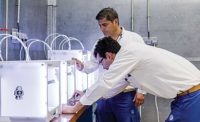3D-Printed Engine Gets Ready for Racing




Although 3D printing is a relatively quick process, creating a final prototype or a production-ready product with the technology can take months or even years. Hungarian college-student team SZEngine can attest to this, having produced the world’s first 3D-printed engine for use in a Formula Student racing car in 2018 after nearly two years of work.
The project began in 2016 when Zoltán Dudás, a 3D metal printing specialist at Audi Hungaria, based in Gyor, Hungary, was instructed to print a fully functioning engine using the SLM280 machine from SLM Solutions Group AG. Upon learning that SZEngine wanted to mill engine parts at the plant’s Motor Manufacturing Center (MMC), Dudás decided to allow the student team to not just mill the components, but print them from scratch with the SLM280.
MMC workers rely on the 2.0 version of this machine, which uses selective laser melting technology to 3D print parts. This technique involves using a high power-density laser to fully melt and fuse metallic powders into a solid three-dimensional part.
AUDI Hungaria established SZEngine in 2008 to work closely with the company’s Internal Combustion Engine and Engine Development Departments. This collaboration helps SZEngine design and develop racing engines for teams that take part in Formula Student, an international racing series in which European college students develop, construct and race their own cars.
For this project, SZEngine began by digitally redesigning all the main components of its 55-hp, single-cylinder engine called the EVO5. This was done because each part required conventional processing and many support structures, which were unsuitable for 3D printing. SZE also felt it was necessary so its new engine, the EVO6, could truly be called “a 3D-printed engine.”
The first component redesigned was the crankcase timing side, done by engineer Dániel Kovari. Other redesigned parts include the two-part crankcase; the cylinder, cylinder head and cylinder head cover; and the covers for the clutch, timing belt, oil filter and oil pump.
After this, each part was 3D printed and mechanically processed, measured and tested. The team then assembled all the components into a complete engine and tested it on a test bench. Finally, the engine was installed in the team’s test car and run.
Dudás is thrilled with the results, as are all members of SZEngine and Ralf Frohwerk, global head of business development at SLM Solutions. “The project clearly shows that metal-based 3D printing is not just suitable for prototypes, but can also be successfully used for series production, especially small batches,” says Frohwerk.
Automobile production at Audi Hungaria began in 1998. Models assembled there over the past 21 years include the Audi TT Coupé and Roadster, and the Audi A3 Sedan, Audi A3 Cabriolet and Audi Q3 Sportback.
The SLM280 machine features a build envelope of 280 by 280 by 365 millimeters and patented multi-beam technology. It can be used to produce metallic components for series and custom production with individual parameters.
Besides automotive customers, SLM Solutions serves those in the aerospace, energy and healthcare industries. For more information on 3D printing machines that use selective laser melting technology, call 248-243-5400 or visit www.slm-solutions.com.
Looking for a reprint of this article?
From high-res PDFs to custom plaques, order your copy today!








